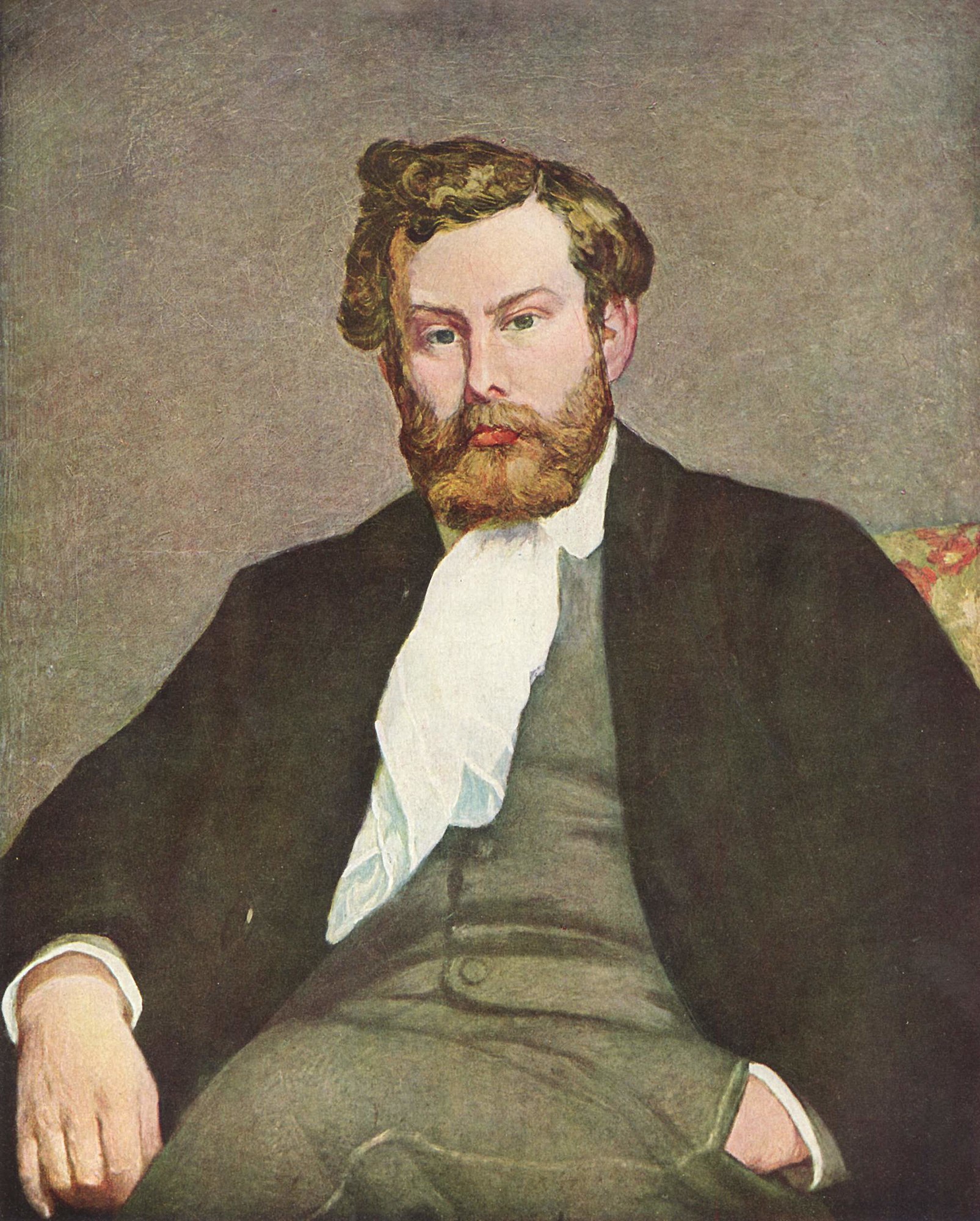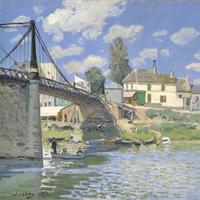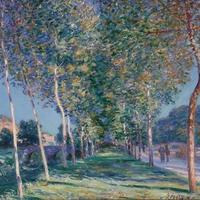More about Alfred Sisley
Works by Alfred Sisley

Sr. Contributor
Sisley struggled with money throughout his entire adult life.
Which must have been made all the more frustrating by his growing up in a hyper-wealthy Paris based merchant family of English heritage. Dear ol' Dad was a silk merchant with a game shipping artificial flowers to South America. Alfred was shipped off to England at age 17 to beef up on all things business only to become gobsmacked by art. Especially works by John Constable and J.M.W. Turner.
Traveling to London, even for just a few months, enamored Alfred of all things painting. Alfred made it clear on his return to Paris that he was all in for the art hustle, business be damned. It pissed off the parentals, but they didn't stand in his way. He joined the same atelier as Monet, Renoir, and Bazille and with them founded the Impressionists. Life was good for a while, and Sisley carved a niche out for himself among the group by devoting his developing talent to landscapes. Things took a turn for the worse when he got bit by the love bug.
Marie Lescouezec came into the picture and unintentionally Yoko-ed the Sisley family unit. Alfred and Marie moved in together (and had a baby soon afterward) without first getting married. His father was furious, and he kicked Alfred's butt right off the gravy train. No bother, though, because Alfred was certain his finances would skyrocket with an internationally renowned painting career...that totally never happened. He'd exhibit and sell nothing, time and again. Then the Franco-Prussian War kicked off and Alfred suffered a hat trick of major issues in rapid succession. The war obliterated the Sisley family business and fortune, first off, so he couldn't trade in on the family credit. Then, a double dose of Prussian bombing destroyed Alfred's beloved painting getaway in Bougival along with ALL. OF. HIS. early paintings.
Bestie Monet lent a hand by introducing Alfred to art dealing maven Paul Durand-Ruel. Things were looking up as Sisley's works were moving regularly out of Durand-Ruel's showroom at a solid profit. But the promise of greater prices tomorrow wasn't enough for Alfred's bills today. He sold his paintings outright to Durand-Ruel to move more, albeit for less per piece. Durand-Ruel took Sisley's paintings to New York and sold them to Americans hungry for the Englishman's ethereal take on the French countryside. The art dealer cashed in and the artist and his family continued in near squalor. Marie stayed by his side, however, even though Alfred didn't pop the question and marry her until 31 years after they moved in together. Each died two years after finally getting married, just three months apart.

Contributor
The world has not forgotten Impressionism, but they did sortof forget Alfred Sisley.
The art world was busy cheering on his friends Claude Monet, Auguste Renoir, and others. Sisley sidled into the background, overshadowed by his more successful pals. The English painter is now ironically remembered as the Forgotten Impressionist.
Alfred Sisley was born to English parents in Paris in 1839. His family had enough money to live comfortably. In short, they were rich. His father was a silk merchant, clearly doing very well for himself. His mother was something of a vintage radio station (radio broadcasting was inititated in the 1920s, she was way ahead of her time). She essentially collected music and probably played DJ for guests at her home in Paris. The Sisleys expected their son to join the family business. He was even sent to London to study Business, but he returned after 4 years without a degree.
I’d expect Sisley’s dad to be really, really angry. “I’ll cut you out of my will” kind of angry. I mean, all of us have had our reasons to drop out of college. But, we’re all thinking the same thing on our way back home. “My dad’s going to kill me." Alfred got lucky, his dad didn’t kill him. Or cut him out of the will. In fact, his dad couldn’t have been more chill. He paid for Alfred’s art achool and even sent him an allowance.
Alfred met Renoir and Monet at the Ecole Beaux des Arts in Paris in 1862. They were all young artists who were admitted to Marc-Charles-Gabriel Gleyre’s atelier. They would often take their canvases outdoors and paint en plein-air. They soon discovered that they really enjoyed painting outside the studio. Their strokes were broader and more tactile, and colors were brighter. With this, Impressionism was born. Sisley was there, making history, albeit with a more subdued palette than some of his peers.
As I was saying, Sisley was a privileged kid. In the 1860s, he and his friends were unable to get their paintings into the Paris Salon. They weren’t able to exhibit in too many places and their wallets were getting used to malnutrition. Except Sisley. He was still getting his allowance, so life was cushy. Unfortunately, in 1870, Sisley’s father went bankrupt. Sisley now had to make a living off his paintings. As a result, he was suddenly thrust into poverty with his girlfriend, Eugènie Lescouezec, and their children.
It almost feels like Karma. He barely had to struggle when his friends were poor, and then he got left behind when his friends got richer. He was unable to find financial “bliss." He did work with art dealers and galleries, but he failed to make it big in his lifetime. He didn’t have many fans back then, and some people still don’t like him. Art historian Robert Rosenblum said his paintings assumed "almost a generic character, an impersonal textbook idea of a perfect Impressionist painting". Yikes.
Sisley died a few months after his wife in 1899. They had just gotten married in 1897 (having been engaged for 30 years). Sisley died poor, alone, and still an Englishman despite his best efforts to become a French citizen.
Sources
- "Alfred Sisley (18391899)." Alfred Sisley: Impressionist Landscape Artist, Biography, Paintings. Accessed August 16, 2019. http://www.visual-arts-cork.com/famous-artists/alfred-sisley.htm.
- "Alfred Sisley Paintings, Bio, Ideas." The Art Story. Accessed August 16, 2019. https://www.theartstory.org/artist/sisley-alfred/.
- Lamb, Bill. "Life and Work of Impressionist Painter Alfred Sisley." ThoughtCo. July 01, 2019. Accessed August 16, 2019. https://www.thoughtco.com/alfred-sisley-4691533.
- "Biography of Alfred Sisley." Alfred Sisley - The Complete Works - Biography. Accessed August 16, 2019. https://www.alfredsisley.org/biography.html.
- Impressionism - Biography of Alfred SISLEY. Accessed August 16, 2019. http://www.impressionniste.net/sisley_alfred.htm.
- Rosenblum, Robert, and Françoise Cachin. Paintings in the Musée DOrsay. New York: Stewart, Tabori & Chang, 1989.
- Jeanette. "Alfred Sisley Paintings." ITravelWithArt. July 29, 2019. Accessed August 19, 2019. https://www.itravelwithart.com/alfred-sisley-paintings/.
Featured Content
Here is what Wikipedia says about Alfred Sisley
Alfred Sisley (/ˈsɪsli/;
French: [sislɛ]; 30 October 1839 – 29 January 1899) was an Impressionist landscape painter who was born and spent most of his life in France, but retained British citizenship. He was the most consistent of the Impressionists in his dedication to painting landscape en plein air (i.e., outdoors). He deviated into figure painting only rarely and, unlike Renoir and Pissarro, he found that Impressionism fulfilled his artistic needs.
Among his important works are a series of paintings of the River Thames, mostly around Hampton Court, executed in 1874, and landscapes depicting places in or near Moret-sur-Loing. The notable paintings of the Seine and its bridges in the former suburbs of Paris are like many of his landscapes, characterised by tranquillity, in pale shades of green, pink, purple, dusty blue and cream. Over the years Sisley's power of expression and colour intensity increased.
Check out the full Wikipedia article about Alfred Sisley












